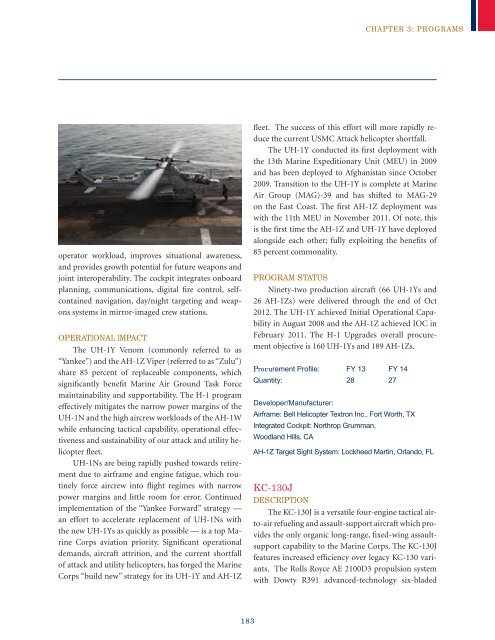USMC Concepts & Programs 2013 - Defense Innovation Marketplace
USMC Concepts & Programs 2013 - Defense Innovation Marketplace
USMC Concepts & Programs 2013 - Defense Innovation Marketplace
You also want an ePaper? Increase the reach of your titles
YUMPU automatically turns print PDFs into web optimized ePapers that Google loves.
chapter 3: programs<br />
operator workload, improves situational awareness,<br />
and provides growth potential for future weapons and<br />
joint interoperability. The cockpit integrates onboard<br />
planning, communications, digital fire control, selfcontained<br />
navigation, day/night targeting and weapons<br />
systems in mirror-imaged crew stations.<br />
Operational Impact<br />
The UH-1Y Venom (commonly referred to as<br />
“Yankee”) and the AH-1Z Viper (referred to as “Zulu”)<br />
share 85 percent of replaceable components, which<br />
significantly benefit Marine Air Ground Task Force<br />
maintainability and supportability. The H-1 program<br />
effectively mitigates the narrow power margins of the<br />
UH-1N and the high aircrew workloads of the AH-1W<br />
while enhancing tactical capability, operational effectiveness<br />
and sustainability of our attack and utility helicopter<br />
fleet.<br />
UH-1Ns are being rapidly pushed towards retirement<br />
due to airframe and engine fatigue, which routinely<br />
force aircrew into flight regimes with narrow<br />
power margins and little room for error. Continued<br />
implementation of the “Yankee Forward” strategy —<br />
an effort to accelerate replacement of UH-1Ns with<br />
the new UH-1Ys as quickly as possible — is a top Marine<br />
Corps aviation priority. Significant operational<br />
demands, aircraft attrition, and the current shortfall<br />
of attack and utility helicopters, has forged the Marine<br />
Corps “build new” strategy for its UH-1Y and AH-1Z<br />
fleet. The success of this effort will more rapidly reduce<br />
the current <strong>USMC</strong> Attack helicopter shortfall.<br />
The UH-1Y conducted its first deployment with<br />
the 13th Marine Expeditionary Unit (MEU) in 2009<br />
and has been deployed to Afghanistan since October<br />
2009. Transition to the UH-1Y is complete at Marine<br />
Air Group (MAG)-39 and has shifted to MAG-29<br />
on the East Coast. The first AH-1Z deployment was<br />
with the 11th MEU in November 2011. Of note, this<br />
is the first time the AH-1Z and UH-1Y have deployed<br />
alongside each other; fully exploiting the benefits of<br />
85 percent commonality.<br />
Program Status<br />
Ninety-two production aircraft (66 UH-1Ys and<br />
26 AH-1Zs) were delivered through the end of Oct<br />
2012. The UH-1Y achieved Initial Operational Capability<br />
in August 2008 and the AH-1Z achieved IOC in<br />
February 2011. The H-1 Upgrades overall procurement<br />
objective is 160 UH-1Ys and 189 AH-1Zs.<br />
Procurement Profile: FY 13 FY 14<br />
Quantity: 28 27<br />
Developer/Manufacturer:<br />
Airframe: Bell Helicopter Textron Inc., Fort Worth, TX<br />
Integrated Cockpit: Northrop Grumman,<br />
Woodland Hills, CA<br />
AH-1Z Target Sight System: Lockheed Martin, Orlando, FL<br />
KC-130J<br />
Description<br />
The KC-130J is a versatile four-engine tactical airto-air<br />
refueling and assault-support aircraft which provides<br />
the only organic long-range, fixed-wing assaultsupport<br />
capability to the Marine Corps. The KC-130J<br />
features increased efficiency over legacy KC-130 variants.<br />
The Rolls Royce AE 2100D3 propulsion system<br />
with Dowty R391 advanced-technology six-bladed<br />
183

















